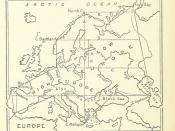Sociology The Comparative Method
Sociologists have embraced what is known as the comparative method as the
most efficient way to expose taken-for-granted 'truths' or laws that people
have adopted. But what is this comparative method and how does it work?
Are there any advantages/disadvantages to exposing these false 'truths'.
What forms or variations of the comparative method exist? In the pages to
follow I will attempt to give you some insight and understanding of what the
comparative method is, and how it works.
The comparative method, simply put, is the process of comparing two things
(in our case societies, or the people that make up society) and seeing if
the result of the comparison shows a difference between the two. The
comparative method attempts to dereify (the process of exposing
misinterpreted norms. Norms that society consider natural and inevitable
characteristics of human existence) reified (the human created norms or
'truths') beliefs.
Obviously there are various ways in which a nomi (a labeled, sometime
constructed, norm or truth) can be exposed. Which form of the comparative
method should one use however? The answer, whichever one applies to the
'truth' in question. For example, you certainly would not do a cross-gender
form of comparison if you wished to expose whether or not homosexuality has
always been feared and looked down upon by most people throughout history.
No, rather you would perform a historical comparison of two or more
different societies to see if these beliefs always existed, or, whether or
not this is a newly constructed belief.
Let's look at little more closely at the above mentioned historical
comparison and see how the comparative method works with a specific example.
There is no question that in today's western society there is a lot of fear
and trepidation towards people who are...



Did you write this
I am unsure whether you have plagiarized this essay or submitted it to two sites as it can also be found here
http://www.antiessays.com/essay.php?eid=133 5
5 out of 5 people found this comment useful.